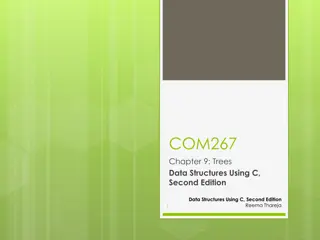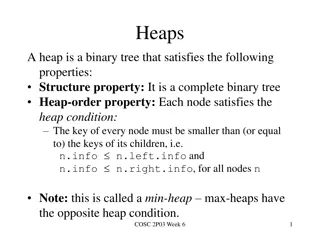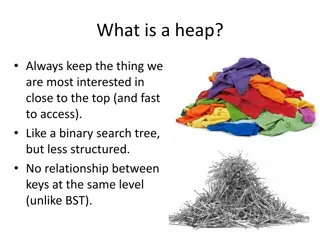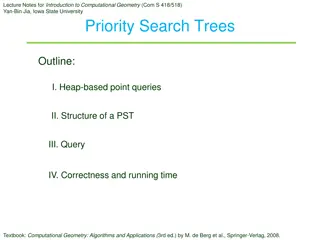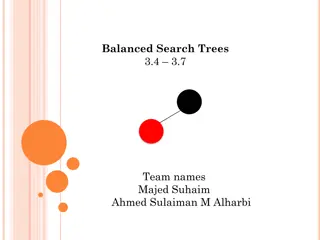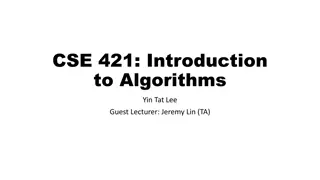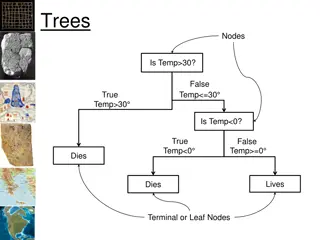Heaps and Multi-way Search Trees
Explore the concepts of heaps, types of heaps, and their applications, along with the implementation of different heaps and indexing techniques. Learn about the differences between B-trees and B+-trees in the context of data structures.
Download Presentation

Please find below an Image/Link to download the presentation.
The content on the website is provided AS IS for your information and personal use only. It may not be sold, licensed, or shared on other websites without obtaining consent from the author.If you encounter any issues during the download, it is possible that the publisher has removed the file from their server.
You are allowed to download the files provided on this website for personal or commercial use, subject to the condition that they are used lawfully. All files are the property of their respective owners.
The content on the website is provided AS IS for your information and personal use only. It may not be sold, licensed, or shared on other websites without obtaining consent from the author.
E N D
Presentation Transcript
Heaps & Multi-way Search Trees Prepared By Keshav Tambre Dept. Of IT Data Structures 1
Unit Objectives: To understand basic concepts of heaps, types of heaps & applications. To understand implementation of different heaps. To understand various indexing techniques. To understand difference between B trees & B+ trees. Dept. Of IT Data Structures 2
Binary Heap A priority queue data structure A binary heap is a binary tree with two properties Heap Structure property Heap Order property Dept. Of IT Data Structures 3
Structure Property A binary heap is a complete binary tree Each level (except possibly the bottom most level) is completely filled The bottom most level may be partially filled (from left to right) Height of a complete binary tree with N elements is N 2 log Dept. Of IT Data Structures 4 4
Heap-order Property Heap-order property (for a MinHeap ) For every node X, key(parent(X)) key(X) Except root node, which has no parent Thus, minimum key always at root Alternatively, for a MaxHeap , always keep the maximum key at the root Insert and deleteMin must maintain heap- order property Dept. Of IT Data Structures 5
Heap Order Property Minimum element Duplicates are allowed Dept. Of IT Data Structures 6
Binary Heap Example N=10 Every level (except last) saturated Array representation: Dept. Of IT Data Structures 7
Implementing Complete Binary Trees as Arrays Given element at position i in the array Left child(i) = at position 2i Right child(i) = at position 2i + 1 Parent(i) = at position / i 2 i 2i 2i + 1 i/2 Dept. Of IT Data Structures 8
Heap Insert Insert new element into the heap at the next available slot ( hole ) According to maintaining a complete binary tree Then, percolate the element up the heap while heap-order property not satisfied Dept. Of IT Data Structures 9
Percolating Up Heap Insert: Example Insert 14: hole 14 Dept. Of IT Data Structures 10
Percolating Up Heap Insert: Example (1) Insert 14: 14 vs. 31 14 hole 14 Dept. Of IT Data Structures 11 11
Percolating Up Heap Insert: Example (1) Insert 14: 14 vs. 31 14 hole 14 (2) 14 vs. 21 14 Dept. Of IT Data Structures 12 12
Percolating Up Heap Insert: Example (1) Insert 14: 14 vs. 31 hole 14 (2) 14 vs. 21 Heap order prop Structure prop (3) 14 14 vs. 13 Path of percolation up Dept. Of IT Data Structures 13 13
Heap DeleteMin Minimum element is always at the root Heap decreases by one in size Move last element into hole at root Percolate down while heap-order property not satisfied Dept. Of IT Data Structures 14
Percolating down Heap DeleteMin: Example Make this position empty Dept. Of IT Data Structures 15
Percolating down Heap DeleteMin: Example Copy 31 temporarily here and move it down Make this position empty Is 31 > min(14,16)? Yes - swap 31 with min(14,16) Dept. Of IT Data Structures 16 16
Percolating down Heap DeleteMin: Example 31 Is 31 > min(19,21)? Yes - swap 31 with min(19,21) Dept. Of IT Data Structures 17
Percolating down Heap DeleteMin: Example 31 31 Is 31 > min(65,26)? Yes - swap 31 with min(65,26) Is 31 > min(19,21)? Yes - swap 31 with min(19,21) Percolating down Dept. Of IT Data Structures 18 18
Percolating down Heap DeleteMin: Example 31 Percolating down Dept. Of IT Data Structures 19
Percolating down Heap DeleteMin: Example 31 Heap order prop Structure prop Dept. Of IT Data Structures 20 20
Building a Heap Construct heap from initial set of N items Method 1 Perform N inserts O(N log2 N) worst-case Method 2 (use buildHeap()) Randomly populate initial heap with structure property Perform a percolate-down from each internal node (H[size/2] to H[1]) To take care of heap order property Dept. Of IT Data Structures 21
Binary Heap Example: Data arrives to be heaped in the order: 54, 87, 27, 67, 19, 31, 29, 18, 32 Dept. Of IT Data Structures 22
Binary Heap 54, 87, 27, 67, 19, 31, 29, 18, 32 Method 1: 54 87 87 54 54 54 27 87 87 87 87 54 27 67 27 67 27 67 54 54 19 23
Binary Heap 54, 87, 27, 67, 19, 31, 29, 18, 32 87 87 67 27 67 27 19 54 19 31 54 24
Binary Heap 54, 87, 27, 67, 19, 31, 29, 18, 32 87 87 67 31 67 31 19 27 29 54 19 27 29 54 18 32 25
BuildHeap Example Input: { 150, 80, 40, 30,10, 70, 110, 100, 20, 90, 60, 50, 120, 140, 130 } Method 2: Leaves are all valid heaps (implicitly) So, let us look at each internal node, from bottom to top, and fix if necessary Arbitrarily assign elements to heap nodes Structure property satisfied Heap order property violated Leaves are all valid heaps (implicit) Dept. Of IT Data Structures 26
BuildHeap Example Swap with left child Nothing to do Randomly initialized heap Structure property satisfied Heap order property violated Leaves are all valid heaps (implicit) Dept. Of IT Data Structures 27 27
BuildHeap Example Swap with right child Nothing to do Dotted lines show path of percolating down Dept. Of IT Data Structures 28 28
BuildHeap Example Swap with right child & then with 60 Nothing to do Dotted lines show path of percolating down Dept. Of IT Data Structures 29
BuildHeap Example Swap path Final Heap Dotted lines show path of percolating down Dept. Of IT Data Structures 30
Applications of Heaps. Operating system scheduling / Priority Queue. Process jobs by priority Graph algorithms. Find shortest path Selection Problem. Heap Sort. Dept. Of IT Data Structures 31
An Application: The Selection Problem Given a list of n elements, find the kth smallest element Algorithm 1: Sort the list Pick the kth element A better algorithm: Use a binary heap (minheap) Dept. Of IT Data Structures 32
Selection using a MinHeap Input: n elements Algorithm: 1. buildHeap(n) 2. Perform k deleteMin() operations 3. Report the kth deleteMin output Dept. Of IT Data Structures 33
Heapsort (1) Build a binary heap of N elements the minimum element is at the top of the heap (2) Perform N DeleteMin operations the elements are extracted in sorted order Dept. Of IT Data Structures 34
Build Heap Input: N elements Output: A heap with heap-order property Method 1: obviously, N successive insertions Complexity: O(NlogN) worst case Dept. Of IT Data Structures 35
Heapsort Running Time Analysis (1) Build a binary heap of N elements repeatedly insert N elements O(N log N) time (2) Perform N DeleteMin operations Each DeleteMin operation takes O(log N) O(N log N) Total time complexity: O(N log N) Dept. Of IT Data Structures 36
Heapsort Observation: after each deleteMin, the size of heap shrinks by 1 We can use the last cell just freed up to store the element that was just deleted after the last deleteMin, the array will contain the elements in decreasing sorted order To sort the elements in the decreasing order, use a min heap To sort the elements in the increasing order, use a max heap Dept. Of IT Data Structures 37
Heap-Sort Example Sort in increasing order: use max heap Delete 97 Dept. Of IT Data Structures 38
Another Heapsort Example Delete 16 Delete 14 Delete 10 Delete 9 Delete 8 Dept. Of IT Data Structures 39
Example (contd) Dept. Of IT Data Structures 40
Other Types of Heaps Binomial Heaps d-Heaps Leftist Heaps Skew Heaps Fibonacci Heaps Dept. Of IT Data Structures 41
B-Trees Dept. Of IT Data Structures 42
Definition of a B-tree A B-tree of order m is an m-way tree (i.e., a tree where each node may have up to m children) in which: 1. the number of keys in each non-leaf node is one less than the number of its children and these keys partition the keys in the children in the fashion of a search tree 2. all leaves are on the same level 3. all non-leaf nodes except the root have at least m / 2 children 4. the root is either a leaf node, or it has from two to m children 5. a leaf node contains no more than m 1 keys The number m should always be odd Dept. Of IT Data Structures 43
An example B-Tree A B-tree of order 5 containing 26 items 26 6 12 42 51 62 1 2 4 7 8 13 15 18 25 27 29 45 46 48 53 55 60 64 70 90 Note that all the leaves are at the same level Dept. Of IT Data Structures 44
Constructing a B-tree Suppose we start with an empty B-tree and keys arrive in the following order:1 12 8 2 25 5 14 28 17 7 52 16 48 68 3 26 29 53 55 45 We want to construct a B-tree of order 5 The first four items go into the root: 1 2 8 12 To put the fifth item in the root would violate condition 5 Therefore, when 25 arrives, pick the middle key to make a new root Dept. Of IT Data Structures 45
Constructing a B-tree (contd.) 1 12 8 2 25 5 14 28 17 7 52 16 48 68 3 26 29 53 55 45 8 1 2 12 25 6, 14, 28 get added to the leaf nodes: 8 1 2 6 12 14 25 28 Dept. Of IT Data Structures 46
Constructing a B-tree (contd.) 1 12 8 2 25 5 14 28 17 7 52 16 48 68 3 26 29 53 55 45 Adding 17 to the right leaf node would over-fill it, so we take the middle key, promote it (to the root) and split the leaf 8 17 1 2 6 12 14 25 28 7, 52, 16, 48 get added to the leaf nodes 8 17 1 2 6 7 12 14 16 25 28 48 52 Dept. Of IT Data Structures 47
Constructing a B-tree (contd.) 1 12 8 2 25 5 14 28 17 7 52 16 48 68 3 26 29 53 55 45 Adding 68 causes us to split the right most leaf, promoting 48 to the root, and adding 3 causes us to split the left most leaf, promoting 3 to the root; 26, 29, 53, 55 then go into the leaves 3 8 17 48 1 2 6 7 12 14 16 25 26 28 29 52 53 55 68 Adding 45 causes a split of 25 26 28 29 and promoting 28 to the root then causes the root to split Dept. Of IT Data Structures 48
Constructing a B-tree (contd.) 1 12 8 2 25 5 14 28 17 7 52 16 48 68 3 26 29 53 55 45 17 3 8 28 48 1 2 6 7 12 14 16 25 26 29 45 52 53 55 68 Dept. Of IT Data Structures 49
Inserting into a B-Tree If Attempt to insert the new key into a leaf this would result in that leaf becoming too big, split the leaf into two, promoting the middle key to the leaf s parent If this would result in the parent becoming too big, split the parent into two, promoting the middle key This strategy might have to be repeated all the way to the top If necessary, the root is split in two and the middle key is promoted to a new root, making the tree one level higher Dept. Of IT Data Structures 50


